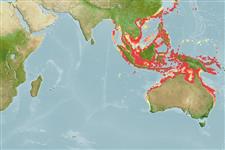Teleostei (teleosts) >
Eupercaria/misc (Various families in series Eupercaria) >
Nemipteridae (Threadfin breams, Whiptail breams)
Etymology: Scolopsis: Greek, skolex = worm + Greek, opsis = appearance (Ref. 45335).
More on author: Cuvier.
Environment: milieu / climate zone / depth range / distribution range
Ecology
Marine; reef-associated; depth range 2 - 50 m (Ref. 90102). Tropical; 32°N - 31°S, 90°E - 157°E (Ref. 3810)
Indo-West Pacific: eastern Indian Ocean (Andaman Sea and northwest Australia) to Papua New Guinea, north to the Ryukyu Islands, south to northeastern Australia. This species has been previously reported as Scolopsis dubiosus (a junior synonym of Scolopsis taeniopterus), or misidentified as Scolopsis temporalis.
Size / Weight / Age
Maturity: Lm ? range ? - ? cm
Max length : 38.0 cm TL male/unsexed; (Ref. 90102); common length : 18.0 cm SL male/unsexed; (Ref. 3810)
Dorsal
spines
(total): 10;
Dorsal
soft rays
(total): 9;
Anal
spines: 3;
Anal
soft rays: 7. Head scales reaching to between anterior margin of eyes and posterior nostrils. Lower limb of preopercle scaly. Antrorse (forward-directed) suborbital spine absent. Pelvic fins long, reaching almost to level of origin of anal fin. Upper lobe of caudal fin a little longer than lower lobe. In larger specimens, lobes produced to form short filamentous extensions in larger specimens. 3 blue stripes on snout; uppermost joining eyes above nostrils. A blue stripe on preopercle behind eye. A blue chevron-shaped stripe running upwards onto opercle from below eye and bending downward towards pectoral-fin base.
Occurs on sand bottoms close to reefs. Often silty habitats (Ref. 48635). Occurs solitary or in small groups. Feeds on small fishes, crustaceans, mollusks and polychaete worms (Ref. 90102). It is parasitised by the monogenean Anoplodiscus hutsonae on the pectoral fins and body surface (Ref. 124057).
Life cycle and mating behavior
Maturity | Reproduction | Spawning | Eggs | Fecundity | Larvae
Also Ref. 103751.
Russell, B.C., 1990. FAO Species Catalogue. Vol. 12. Nemipterid fishes of the world. (Threadfin breams, whiptail breams, monocle breams, dwarf monocle breams, and coral breams). Family Nemipteridae. An annotated and illustrated catalogue of nemipterid species known to date. FAO Fish. Synop. 125(12):149p. Rome: FAO. (Ref. 3810)
IUCN Red List Status (Ref. 130435)
Threat to humans
Harmless
Human uses
Fisheries: minor commercial
More information
ReferencesAquacultureAquaculture profileStrainsGeneticsElectrophoresesHeritabilityDiseasesProcessingNutrientsMass conversion
Tools
Special reports
Download XML
Internet sources
Estimates based on models
Preferred temperature (Ref.
123201): 24.9 - 29.1, mean 28.2 °C (based on 982 cells).
Phylogenetic diversity index (Ref.
82804): PD
50 = 0.5000 [Uniqueness, from 0.5 = low to 2.0 = high].
Bayesian length-weight: a=0.01905 (0.01050 - 0.03457), b=3.03 (2.88 - 3.18), in cm total length, based on LWR estimates for this species & Genus-body shape (Ref.
93245).
Trophic level (Ref.
69278): 3.5 ±0.5 se; based on diet studies.
Resilience (Ref.
120179): Medium, minimum population doubling time 1.4 - 4.4 years (Preliminary K or Fecundity.).
Fishing Vulnerability (Ref.
59153): Low to moderate vulnerability (28 of 100).
Nutrients (Ref.
124155): Calcium = 46.1 [28.8, 89.1] mg/100g; Iron = 0.601 [0.298, 1.483] mg/100g; Protein = 19 [17, 21] %; Omega3 = 0.143 [0.087, 0.238] g/100g; Selenium = 32 [19, 56] μg/100g; VitaminA = 66.9 [19.2, 186.7] μg/100g; Zinc = 1.16 [0.82, 1.66] mg/100g (wet weight);
